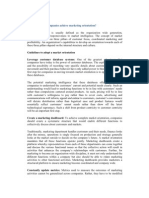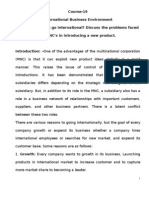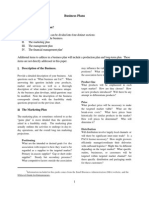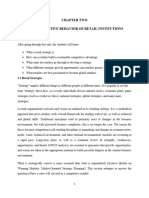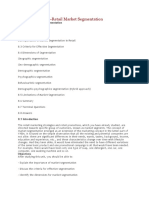0 ratings0% found this document useful (0 votes)
43 viewsIndustrial Marketing Final Sem
Industrial Marketing Final Sem
Uploaded by
Raj KumarThe document discusses why studying industrial marketing is important. It notes that in the 1980s, many firms saw weaknesses in areas like product development, market development, logistics, and competition. Successful industrial marketing requires skills in areas like market planning, research, sales forecasting, product planning, and pricing strategies. Mastering these areas through continuous learning is necessary for marketing professionals to overcome weaknesses and keep up with changes in the market. The document also provides examples of different types of exchanges that occur in industrial markets, such as product, information, financial, and social exchanges.
Copyright:
© All Rights Reserved
Available Formats
Download as DOCX, PDF, TXT or read online from Scribd
Industrial Marketing Final Sem
Industrial Marketing Final Sem
Uploaded by
Raj Kumar0 ratings0% found this document useful (0 votes)
43 views21 pagesThe document discusses why studying industrial marketing is important. It notes that in the 1980s, many firms saw weaknesses in areas like product development, market development, logistics, and competition. Successful industrial marketing requires skills in areas like market planning, research, sales forecasting, product planning, and pricing strategies. Mastering these areas through continuous learning is necessary for marketing professionals to overcome weaknesses and keep up with changes in the market. The document also provides examples of different types of exchanges that occur in industrial markets, such as product, information, financial, and social exchanges.
Original Description:
xfxffffff
Copyright
© © All Rights Reserved
Available Formats
DOCX, PDF, TXT or read online from Scribd
Share this document
Did you find this document useful?
Is this content inappropriate?
The document discusses why studying industrial marketing is important. It notes that in the 1980s, many firms saw weaknesses in areas like product development, market development, logistics, and competition. Successful industrial marketing requires skills in areas like market planning, research, sales forecasting, product planning, and pricing strategies. Mastering these areas through continuous learning is necessary for marketing professionals to overcome weaknesses and keep up with changes in the market. The document also provides examples of different types of exchanges that occur in industrial markets, such as product, information, financial, and social exchanges.
Copyright:
© All Rights Reserved
Available Formats
Download as DOCX, PDF, TXT or read online from Scribd
Download as docx, pdf, or txt
0 ratings0% found this document useful (0 votes)
43 views21 pagesIndustrial Marketing Final Sem
Industrial Marketing Final Sem
Uploaded by
Raj KumarThe document discusses why studying industrial marketing is important. It notes that in the 1980s, many firms saw weaknesses in areas like product development, market development, logistics, and competition. Successful industrial marketing requires skills in areas like market planning, research, sales forecasting, product planning, and pricing strategies. Mastering these areas through continuous learning is necessary for marketing professionals to overcome weaknesses and keep up with changes in the market. The document also provides examples of different types of exchanges that occur in industrial markets, such as product, information, financial, and social exchanges.
Copyright:
© All Rights Reserved
Available Formats
Download as DOCX, PDF, TXT or read online from Scribd
Download as docx, pdf, or txt
You are on page 1of 21
Why Study Industrial Marketing?
With the increasing marketing competency of the 1980’s,
managements of many firms saw some weaknesses in their
organizations and that resulted in
1. Lack of guidance and stimulation for research and
development of new products.
2. Lack in developing markets for new products.
3. Lack of methods for promoting products to customers
in the face of cost & promotional factors.
4. Lack in innovation of logistics with the needs of
industrial customers on national and global basis. .
5. Lack in meeting the new competition through
traditional ways of business.
6. An inability to modify product positioning. The
marketing people needed to correct such situations with
experiences of the marketplace.
7. Industrial practitioners have defined the skills needed
for success in industrial marketing as they dictate the
market.
• Market Planning
• Market Analysis
• Sales Forecasting
• Market Research
• Product Planning
• New Product Development
• Product Management
• Pricing Strategies
• Price Theory
• Sales Management
These ten qualities and some more were the basic
requirements of successful marketing of the marketing
people. It was necessary for continuous upgrade of
knowledge and skill development for the marketing men
in these areas of marketing management.
Failing which the six lack of functions of marketing
mentioned above could not or would be very difficult to
overcome.
To make the subject of Industrial Marketing more
precise and to make the career of people in Industrial
Marketing, research methodology in marketing,
marketing planning & market forecasting techniques are
viewed as the most important areas of study.
1.Product exchange: Supply of raw materials to the
organization to process the finished goods for the end user or
consumer. Examples can be many. Supply of soap/ detergent
powder to the manufacturers of soaps or detergents. To HLL
there must be suppliers of the raw materials of soap/
detergent raw materials to give the end product s like Rin
Detergent Bar or Surf Excel.
2. Information Exchange: When one organization gives the
technical knowledge, economic consultancy, or giving replies
to organizational questions to another organization it is
termed as information exchange. To site an example we say
that the installation of sophisticated software’s in an
organization and operating system of that software can be
termed as information exchange.
3. Financial Exchange: Grant of credit facilities to an
organization is financial exchange. Exchange of currency from
one organization to another country. Example of this we can
say the functioning of Industrial Development Bank of India
(IDBI), which grants loans to industries.
4. Social Exchange: Social exchange is important in areas of
reducing uncertainty between buyer and seller, avoiding
short-term difficulties and thus maintaining a better relation
over a long period of time. We repeat our statement again
that though consumer marketing and industrial marketing
have the same tenets but significant differences do exist.
Those can be:
a. Market Size
b. The Geographic Concentration
c. The Competitive Nature of the Market.
Industrial Versus Consumer Marketing Management While
the basic tasks of marketing management apply in both the
consumer and industrial markets, unique forces combine to
pose special challenges for the industrial marketing manager.
In the industrial market, markets are relatively concentrated
and channels of distribution are shorter; buyers are well
informed, highly organized, and sophisticated in purchasing
techniques; and multiple influencers con-tribute different
points of view to purchasing decisions.
Thus, industrial marketing creates its own set of conditions
for marketing decisions. As in the consumer market,
industrial marketers must define their target mar-kets,
determine the needs of those markets, design products and
services to fill those needs, and develop programs to reach
and satisfy those markets. However, in comparison to
consumer marketing, industrial marketing is more a
responsibility of general management.
In fact, many industrial executives have difficulty in
separating marketing from corporate strategy and policy. In
consumer marketing, changes in marketing strategy are often
carried out completely within the marketing department
through changes in advertising, promotion, and packaging.
However, as Figure 1-1 indicates, changes in industrial
marketing strategy tend to have company wide implications.
Such implications may involve departures from traditional
engineering and manufacturing techniques or major shifts in
developmental emphasis.
As. in the case of Caterpillar, this may require capital
commitments for new plants and equipment. (To revamp
one 40-year old facility will take Caterpillar five years and
$200 million)? Although marketing may identify the need for
such departures from tradition, decisions on such departures
are often the responsibility of general management, which
must provide the follow-through in all functional areas.
Joint Venture With economic liberalization, came a spate of
joint ventures and collaboration.
There are three distinct phases in the lifetime of a Joint
Venture-an exploratory period when the partners explore
their form of a marketing arrangement, a technology transfer
deal and a licensing arrangement.
Once the decision of financial participation has been taken,
the Joint Venture enters its first phase. The transnational
secures quick entry into a foreign market, sometimes even
adding strong local brands to its portfolio, and amasses
knowledge about the market, the business environment, the
regulatory framework, the cultural nuances, and the
necessary skills.
On this part, the Indian partner gains, technology,
contemporary management practices, and perhaps most
important protection from another competitors through the
alliance with a powerful, financially strong global player. The
second phase begins when these companies start plateauing.
When, market penetration is completed, older brands are
milked and replaced by the transactional ‘s brands, and
familiarity with local conditions is achieved. The Indian
partners acquire information on technology. Management
skills are transferred.
Access to export markets has been assured. The partners
utilize the changing developments to rework their objectives;
many of the original compulsions which catalyzed the
formation of Joint venture are discarded, with their place
being taken by a set of other objectives. To fulfill them, the
partners have to renegotiate the terms and conditions of
their alliance; either reinventing their existing joint venture in
the process, or dissolving it and start a new one instead, thus
entering the third phase of Joint Venture.
17. Grt
promotions.ppt
Refer entire ppt
THE BUYING CENTER
CONCEPT
• Buying center Participants in an organizational buying
action.
BUYING CENTER ROLES
Decider
Buyer
Users
Gatekeeper
Influencer
You might also like
- Quiz Unidad 4 (Semana 5)Document7 pagesQuiz Unidad 4 (Semana 5)lida diaz100% (3)
- Marstrat Sesi 4Document5 pagesMarstrat Sesi 4BUNGA DENINANo ratings yet
- Spitzer CCNY Annual Report 2022-23Document13 pagesSpitzer CCNY Annual Report 2022-23CCNY CommunicationsNo ratings yet
- Panch Kalyanak Mahotsav - A Brief Introduction: Five Auspicious Events Are: Day One: Garbha-Klyanak-Inception CeremonyDocument2 pagesPanch Kalyanak Mahotsav - A Brief Introduction: Five Auspicious Events Are: Day One: Garbha-Klyanak-Inception CeremonyPamNo ratings yet
- Perceptual MapDocument17 pagesPerceptual Mapthu_bui_18100% (1)
- Portrait of Mona LisaDocument2 pagesPortrait of Mona Lisamae sherisse caayNo ratings yet
- Industrial Marketing in IndiaDocument4 pagesIndustrial Marketing in IndiaRahul Jain100% (2)
- Software StrategyDocument18 pagesSoftware StrategyrityupadhNo ratings yet
- B2B AssignmentDocument7 pagesB2B AssignmentNitish AgrawalNo ratings yet
- CH1 MKT STGDocument5 pagesCH1 MKT STGsaraNo ratings yet
- International Business Environment Assignment 1Document5 pagesInternational Business Environment Assignment 1mechidream0% (2)
- Strategic Marketing 10th Edition Cravens Solutions Manual 1Document74 pagesStrategic Marketing 10th Edition Cravens Solutions Manual 1michael100% (46)
- Strategic Marketing 10th Edition Cravens Solutions Manual 1Document36 pagesStrategic Marketing 10th Edition Cravens Solutions Manual 1guymontgomerygpbocfyamt100% (43)
- Role of Marketing in SMEs Week 8Document7 pagesRole of Marketing in SMEs Week 8ashfaqarooba0No ratings yet
- Marketing Strategy2 NotesDocument29 pagesMarketing Strategy2 NotesMohamed El ShalakanyNo ratings yet
- Marketing - Strategic MarketingDocument3 pagesMarketing - Strategic MarketingLiv DNo ratings yet
- 5 C Analysis PEST Analysis SWOT AnalysisDocument4 pages5 C Analysis PEST Analysis SWOT Analysisavisekghosh2015No ratings yet
- Global Marketing: How Do Standardise and Customise The Products Globally?Document7 pagesGlobal Marketing: How Do Standardise and Customise The Products Globally?RajaRajeswari.LNo ratings yet
- Unit 14 Marketing Planning Pearson BTEC Level 5 HND Diploma in BusinessDocument20 pagesUnit 14 Marketing Planning Pearson BTEC Level 5 HND Diploma in BusinessJordan BelfortNo ratings yet
- Introducing New Market Offerings - Managing A Holistic Marketing OrganisationDocument9 pagesIntroducing New Market Offerings - Managing A Holistic Marketing OrganisationAnonymous p0bBEKNo ratings yet
- SITXMPR007 Assessment 1 Short AnswerDocument8 pagesSITXMPR007 Assessment 1 Short AnswerNitika PummaNo ratings yet
- Discussion QuestionsDocument5 pagesDiscussion Questionsbokikg87No ratings yet
- Short Answer Questions - Marketing Principles: Chapter 1: Marketing in A Changing WorldDocument7 pagesShort Answer Questions - Marketing Principles: Chapter 1: Marketing in A Changing WorldSaqib Hanif0% (1)
- Chapter 11Document9 pagesChapter 11oranghebat0% (1)
- Marketing Management BCOM NotesDocument4 pagesMarketing Management BCOM NotesBashir Murei0% (1)
- Importance of Potential MarketDocument5 pagesImportance of Potential Markethira ichiNo ratings yet
- ADL 02 Marketing Management V4Document7 pagesADL 02 Marketing Management V4solvedcareNo ratings yet
- Unit 4.1 Role of Marketing NotesDocument12 pagesUnit 4.1 Role of Marketing Notesalexandra25No ratings yet
- Group 1 Sales ManagementDocument16 pagesGroup 1 Sales ManagementscarletvillanuevaNo ratings yet
- The Critical Role of MarketingDocument5 pagesThe Critical Role of MarketingNalalMunaNo ratings yet
- Module 5 BMEC 2 SimplifiedDocument5 pagesModule 5 BMEC 2 SimplifiedMergierose DalgoNo ratings yet
- Q4 ABM Principles of Marketing 11 Week 4 6Document4 pagesQ4 ABM Principles of Marketing 11 Week 4 6MaRlon Talactac OnofreNo ratings yet
- 06-05 Assignment Module 3 International Product Policy - PlanningDocument6 pages06-05 Assignment Module 3 International Product Policy - Planningbhiwandi pigeonsNo ratings yet
- Personal Assignement MMDocument4 pagesPersonal Assignement MMemelyseuwaseNo ratings yet
- Entre CH 5Document30 pagesEntre CH 5Sena KenaNo ratings yet
- What Goes in A Business Plan?Document3 pagesWhat Goes in A Business Plan?lungu nicoletaNo ratings yet
- Module 3 - Fund Bus 200Document9 pagesModule 3 - Fund Bus 200Crystal BlackNo ratings yet
- IM 4th SemDocument20 pagesIM 4th Semdarthvader005No ratings yet
- International Business Management Final SyllabceDocument8 pagesInternational Business Management Final Syllabcemudsarjabbar628No ratings yet
- Promotions Opportunity Analysis - PPT Integrated Marketing CommunicationDocument30 pagesPromotions Opportunity Analysis - PPT Integrated Marketing Communicationm_dattaias100% (3)
- Project On Parag MilkDocument74 pagesProject On Parag Milkrais100% (1)
- Department of Accounting and Information Systems: Bba 1 Year 1 Semester AIS: 1104 Introduction To BusinessDocument6 pagesDepartment of Accounting and Information Systems: Bba 1 Year 1 Semester AIS: 1104 Introduction To BusinessMehedi HasanNo ratings yet
- Industrial MarketingDocument16 pagesIndustrial MarketingTeddy DavisNo ratings yet
- MMPC 6 em 2024 25Document16 pagesMMPC 6 em 2024 25dimple agrawalNo ratings yet
- Assignment No. 01 Autumn, 2016: Marketing Management (8511) MBA / M. ComDocument13 pagesAssignment No. 01 Autumn, 2016: Marketing Management (8511) MBA / M. ComDanyal ChaudharyNo ratings yet
- Chapter One: 1.1 Backround of The StudyDocument33 pagesChapter One: 1.1 Backround of The StudyAlatishe TaiwoNo ratings yet
- Review and Discussion Questions: External OpportunitiesDocument4 pagesReview and Discussion Questions: External OpportunitiesMuthiah Farah100% (1)
- Sales Forecasting - Part 1Document10 pagesSales Forecasting - Part 1pravendrakumarNo ratings yet
- Lesson 4 Product ManagementDocument14 pagesLesson 4 Product Managementrheyee80No ratings yet
- Task 1 1.1 Compare Marketing As Defined by The CIM (UK) and AMA (US)Document16 pagesTask 1 1.1 Compare Marketing As Defined by The CIM (UK) and AMA (US)Gordo012100% (1)
- Week 4Document18 pagesWeek 4istiak ahammedNo ratings yet
- Organize An EnterpriseDocument50 pagesOrganize An EnterpriseanwarNo ratings yet
- Strategic Planning and Implementation & Strategic Marketing ManagementDocument16 pagesStrategic Planning and Implementation & Strategic Marketing Managementyuvraj9898No ratings yet
- Retail Marketing Chapter Two - convertedDocument8 pagesRetail Marketing Chapter Two - convertedemergencynewasNo ratings yet
- Week2 - EntrepreneurshipDocument7 pagesWeek2 - EntrepreneurshipJewell Fiona KayeNo ratings yet
- Tmbme2 Module 3Document24 pagesTmbme2 Module 3Dimple BolotaoloNo ratings yet
- Activity4 AliDocument6 pagesActivity4 AliMOHAMMAD AL-RASHID ALINo ratings yet
- 103 - Marketing ManagementDocument14 pages103 - Marketing ManagementRiyaz BabwaniNo ratings yet
- Marketing Exam 1Document2 pagesMarketing Exam 1Carlos Bustamante QuijanoNo ratings yet
- Retail Market SegmentationDocument13 pagesRetail Market SegmentationvershaNo ratings yet
- Shaurya - Digvijay - Submission ThreeDocument4 pagesShaurya - Digvijay - Submission Threedigvijay.singh0289No ratings yet
- Rahul PJP Plan For MarchDocument6 pagesRahul PJP Plan For MarchRaj KumarNo ratings yet
- Sachin Pathak PJP Plan For MarchDocument6 pagesSachin Pathak PJP Plan For MarchRaj KumarNo ratings yet
- Creativity & INNOVATIONDocument10 pagesCreativity & INNOVATIONRaj KumarNo ratings yet
- Vinod Gupta Actual Working For AprilDocument5 pagesVinod Gupta Actual Working For AprilRaj KumarNo ratings yet
- Yogendra Sigh Actual Working For AprilDocument5 pagesYogendra Sigh Actual Working For AprilRaj KumarNo ratings yet
- Rajkumar Chaurasiya Actual Working For AprilDocument5 pagesRajkumar Chaurasiya Actual Working For AprilRaj KumarNo ratings yet
- Sachin Pathak Actual Working For AprilDocument5 pagesSachin Pathak Actual Working For AprilRaj KumarNo ratings yet
- Rakesh Sharma Actual Working For AprilDocument5 pagesRakesh Sharma Actual Working For AprilRaj KumarNo ratings yet
- Prakash Dwivedi Actual Working For AprilDocument5 pagesPrakash Dwivedi Actual Working For AprilRaj KumarNo ratings yet
- Mahendra Singh Actual Working For AprilDocument5 pagesMahendra Singh Actual Working For AprilRaj KumarNo ratings yet
- Ajay Jadhav Actual Working For AprilDocument5 pagesAjay Jadhav Actual Working For AprilRaj KumarNo ratings yet
- Scope and Importance of Branding of Coca ColaDocument6 pagesScope and Importance of Branding of Coca ColaRaj KumarNo ratings yet
- Pankaj Yadav Actual Working For AprilDocument5 pagesPankaj Yadav Actual Working For AprilRaj KumarNo ratings yet
- Cyyzkewr PDF 1726370942Document63 pagesCyyzkewr PDF 1726370942MisterepicnussNo ratings yet
- Bba ListDocument21 pagesBba Listtonny buddyNo ratings yet
- Chapter 3 Lesson 2 - Group 9Document23 pagesChapter 3 Lesson 2 - Group 9LalicanTeresa 1BTLEDANo ratings yet
- Reevaluation FormDocument2 pagesReevaluation FormkanchankonwarNo ratings yet
- Creative Writing Hand OutsDocument6 pagesCreative Writing Hand OutsavynsierraNo ratings yet
- Maritime Salvage Arbitration Under LOF 2000Document15 pagesMaritime Salvage Arbitration Under LOF 2000Lesther Antonio OrtegaNo ratings yet
- SDWAN (Software Defined-WAN) Technology Evaluation and ImplementationDocument17 pagesSDWAN (Software Defined-WAN) Technology Evaluation and ImplementationWasayefNo ratings yet
- CaseMine JudgementDocument38 pagesCaseMine JudgementNITIN GUPTANo ratings yet
- Ineke Elfira Juniar - Tugas BHS Inggris Lanjut - Meeting 1Document4 pagesIneke Elfira Juniar - Tugas BHS Inggris Lanjut - Meeting 1Ineke ElfiraNo ratings yet
- KY-06 GHY For Amy McGrath (April 2018)Document3 pagesKY-06 GHY For Amy McGrath (April 2018)Daily Kos ElectionsNo ratings yet
- What Exactly Is Fund Transfer Pricing?: Professor Jean DermineDocument2 pagesWhat Exactly Is Fund Transfer Pricing?: Professor Jean DermineJames BestNo ratings yet
- WB Answer Key - Intermediate 2Document6 pagesWB Answer Key - Intermediate 2Erica YamNo ratings yet
- EU Blockchain Ecosystem Report - Final - 0Document200 pagesEU Blockchain Ecosystem Report - Final - 0Vitaliy Che KogoNo ratings yet
- MAAK MEMBERSHIP APPLICATION FORM BackDocument3 pagesMAAK MEMBERSHIP APPLICATION FORM BackCrystal Moon PescadillaNo ratings yet
- Executive Diploma in Mine Management 2025 Intake_compressedDocument1 pageExecutive Diploma in Mine Management 2025 Intake_compressedSanduramu PerterTawandaNo ratings yet
- Manishkumar SnowDocument2 pagesManishkumar Snowthrillersai75No ratings yet
- D.O. Inv. 4 Ace AnswersDocument3 pagesD.O. Inv. 4 Ace Answersnew vivyNo ratings yet
- Paul Raymond PublicationsDocument3 pagesPaul Raymond Publicationsnikoboj523No ratings yet
- Lesson 3 - Professional Ethics in Hospitality Management: Learning ObjectivesDocument3 pagesLesson 3 - Professional Ethics in Hospitality Management: Learning ObjectivesNathanNo ratings yet
- Processor Stock ReportDocument26 pagesProcessor Stock ReportGauravNo ratings yet
- Final Prospectus Part - A Ini-Cet PG July 2022 Session Information Brochure As On 25.03.2022 15 - 40Document25 pagesFinal Prospectus Part - A Ini-Cet PG July 2022 Session Information Brochure As On 25.03.2022 15 - 40Meetali AggarwalNo ratings yet
- Upper Intermediate Audio Script Unit 10Document9 pagesUpper Intermediate Audio Script Unit 10yahya123No ratings yet
- Re Hi, I Just Upgraded My CRO Stake To 5000 CRO and I Would Like To UpDocument3 pagesRe Hi, I Just Upgraded My CRO Stake To 5000 CRO and I Would Like To UpBenjaminNo ratings yet
- DOcks-and-Harbours-MCQs-PDF 2 PDFDocument5 pagesDOcks-and-Harbours-MCQs-PDF 2 PDFVijendra100% (1)
- How To Read Your Bible PDFDocument68 pagesHow To Read Your Bible PDFNirma SuperNo ratings yet
- Anand Dailer Data 2203Document446 pagesAnand Dailer Data 2203Anand shrivastavaNo ratings yet








